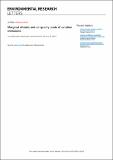Marginal climate and air quality costs of aviation emissions
Author(s)
Grobler, Carla; Wolfe, Philip James; Dasadhikari, Kingshuk; Dedoussi, Irene C; Allroggen, Florian; Speth, Raymond L; Eastham, Sebastian David; Agarwal, Akshat; Staples, Mark Douglas; Sabnis, Jayant S.; Barrett, Steven R. H.; ... Show more Show less
DownloadPublished version (717.5Kb)
Publisher with Creative Commons License
Publisher with Creative Commons License
Creative Commons Attribution
Terms of use
Metadata
Show full item recordAbstract
Aviation emissions have been found to cause 5% of global anthropogenic radiative forcing and ∼16 000 premature deaths annually due to impaired air quality. When aiming to reduce these impacts, decision makers often face trade-offs between different emission species or impacts in different times and locations. To inform rational decision-making, this study computes aviation's marginal climate and air quality impacts per tonne of species emitted and accounts for the altitude, location, and chemical composition of emissions. Climate impacts are calculated using a reduced-order climate model, and air quality-related health impacts are quantified using marginal atmospheric sensitivities to emissions from the adjoint of the global chemistry-transport model GEOS-Chem in combination with concentration response functions and the value of statistical life. The results indicate that 90% of the global impacts per unit of fuel burn are attributable to cruise emissions, and that 64% of all damages are the result of air quality impacts. Furthermore, nitrogen oxides (NO x ), carbon dioxide (CO2), and contrails are collectively responsible for 97% of the total impact. Applying our result metrics to an example, we find that a 20% NOx stringency scenario for new aircraft would reduce the net atmospheric impacts by 700 m USD during the first year of operation, even if the NO x emission reductions cause a small increase in CO2 emissions of 2%. In such a way, the damage metrics can be used to rapidly evaluate the atmospheric impacts of market growth as well as emissions trade-offs of aviation-related policies or technology improvements.
Date issued
2019-11Department
Massachusetts Institute of Technology. Laboratory for Aviation and the Environment; Massachusetts Institute of Technology. Department of Aeronautics and AstronauticsJournal
Environmental Research Letters
Publisher
IOP Publishing
Citation
Grobler, Carla et al. "Marginal climate and air quality costs of aviation emissions." Environmental Research Letters 14, 11 (November 2019): 114031 © 2019 The Author(s)
Version: Final published version
ISSN
1748-9326